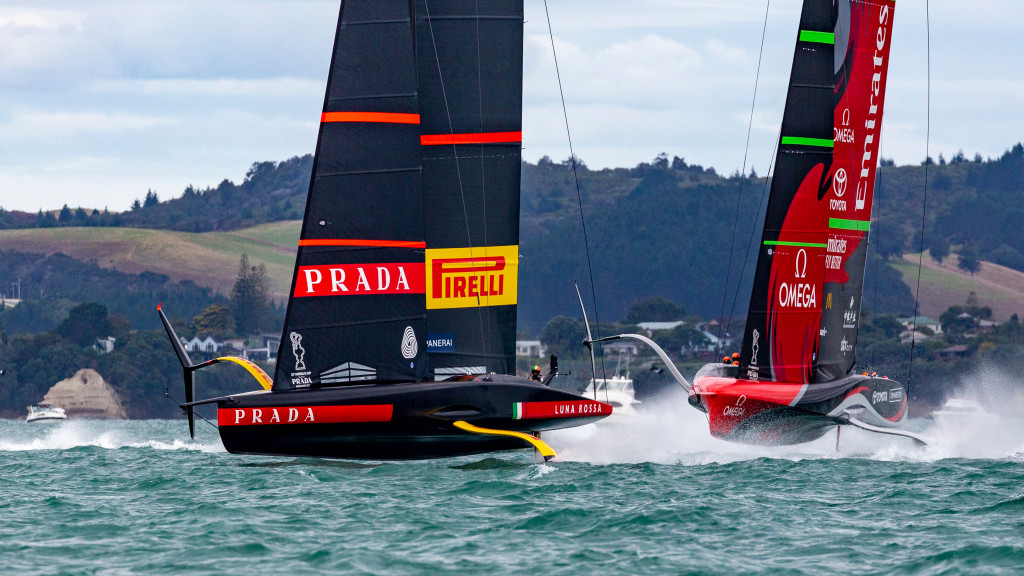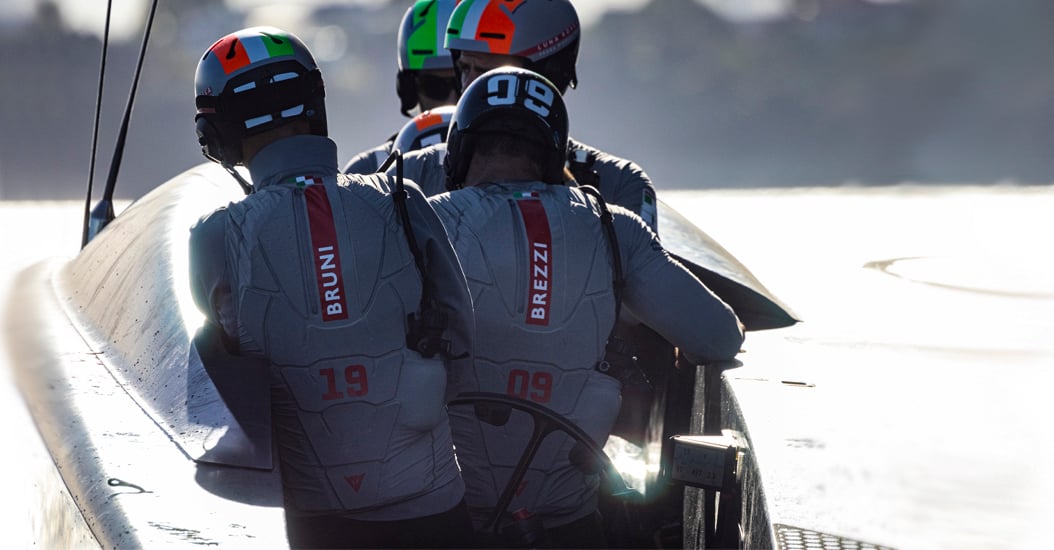From MotoGP to the America's Cup, this is Andrea Zugna's path. He has been working in the World Championship since 2004, with Yamaha Factory Racing first and then with Honda Racing Corporation, and he's in charge of Performance Engineering and Electronic Controls. Zugna tells to Dainese what are the main differences and the points of contact between these worlds, which seem to be totally apart: first class athletes, extremely advances machines and brutal forces to deal with.
"In both sports, a rider or crew take a high-performance vehicle “to the limit”. The more extreme and faster the bike or boat, the harder it becomes to control it, and the talent of the rider or sailor is not enough. In my case, trying to keep an America's Cup boat stable and under control as it flies just a few inches above the water (I developed the flight and implementation controls for the flaps and rudder) is very similar to developing the electronic controls for a MotoGP™ bike, which I have worked on in the past. Something that the AC75 America's Cup sailboat and a MotoGP™ bike have in common is probably the three-dimensionality of their behavior, and this is what makes them both interesting and difficult."
"The AC75 is a much larger and heavier object, so the forces involved are much greater. But what is similar is the acceleration. A MotoGP™ bike normally reaches a lateral g-force of 1.7 to 1.8 in cornering, while an AC75 can get up to 1.5 when maneuvering. But with a motorcycle, we're talking about roughly 230kg (with rider), while for a AC75 with crew we're talking about almost eight tons. To see it in person is truly amazing."
"Both have to get their vehicles performing to their maximum potential while simultaneously managing strategy and overtaking maneuvers. Whereas the best MotoGP™ riders look at the big screens while they are racing to check on the rider behind them, America's Cup sailors steer a boat launched at almost 100km/h, crossing within a few meters and assessing the field to read the sea winds. A true champion is able to ride, or sail, using only one part of his brain, while remaining lucid and using the other part to manage the race."
Every athlete has their own pre-race routine. Some have their own rituals and want to be alone to focus, some can chat and joke up until a few minutes before the start, while others obsessively check their equipment. It's a very personal thing.
With sailors, a lot depends on their role, as a helmsman, flight controller or trimmer has a more mental approach to the race, while a grinder, as well as preparing mentally for the sail control part, clearly needs to warm up and focus much more on their physical performance.
Their ability to surround themselves with a calm, united and determined team. They are both very different, but over the years they have each built a group that they can rely on. And that, along with their riding talent, is the key to the results they have achieved. Although practicing an individual sport, they are fantastic team players with their group of technicians.
Max has no filters. He’s direct and full of enthusiasm, which makes him a born leader. You may or may not like him, but you’ll follow him into battle. Of the three, Jimmy is the most rider-like, pure instinct. Perhaps he needs more guidance with the technical part, but when it’s time for the pre-start, he’s a machine. Checco is limitless, generous, funny, a complete sailor who is his own data engineer... He never ceases to amaze you.
In motorcycling, a talented rider can make up for any technical shortcomings in the vehicle. Rossi, Stoner and Marquez have all won titles on inferior vehicles, managing the race or the championship better than others. In the America's Cup, it's much harder to win with a slower boat, even by a small margin, perhaps because there are more straights and fewer turns. Our guys raced like lions, winning most of the starts and windward stretches, and had better tactics, but unfortunately that wasn’t enough.

The development of Sea-Guard, the racing jacket for Luna Rossa Prada Pirelli and Emirates Team New Zealand.
"In both cases, the weather plays a decisive role. With the single tire supplier, choosing the right tire based on track temperature, and adapting the bike to it, is critical. Then there is the preparation of the set-up and mappings over the race weekend, but everything is increasingly centered around tire management.
On a boat, and as well as selecting the sails based on the weather forecast, there is the study and interpretation of the race course, the wind shifts, the current. The boat remains more or less the same from one day to the next, but the adjustments and possible tactical choices are infinite. There is also a huge amount of maintenance to ensure the reliability of an extremely complex vehicle, especially in terms of its control systems."
"The America's Cup is wonderful and cruel. A team spends years preparing its boat and crew and then it all plays out over just a few months. There are so many ways not to win, and there are those who have spent their entire lives chasing a victory without ever even reaching the finals. For this reason, winning a single race is a much more intense emotion than a single MotoGP™ race. And then there is the nature of the Cup, which is a competition between nations. We were thrilled and moved by the affection and support that the Italians showed us."
"MotoGP™ is very mature and there are very restrictive regulations to reduce costs. This means the development cycle of the bike involves small-scale evolution and subsequent refinements. But with the America's Cup, I found a field where the strangest and most revolutionary ideas are still possible and we can be dreamers and inventors, seeing our ideas tested at sea in the space of just a few days. It’s basically an engineer's playground."
"The America's Cup without a doubt. This cycle has been particularly groundbreaking, with the introduction of a completely new boat. A few days ago we received confirmation that the AC75 boat class will remain for the next two Cup cycles. This brings stability and, as time goes by, the boats will evolve and become more and more refined. But for now, the class is still young and we can expect big differences with respect to the boats we have seen until now."
"The main revolution of this Cup has been the introduction of a flying monohull of significant size, complete with foil arms to guarantee the righting moment of a catamaran. This makes the AC75 boats incredibly fast (especially bowline side) but also maneuverable to the point that we have seen some exciting tacking and jibing battles.
The real challenge though will be to make this technology usable for a larger audience, by simplifying it. An AC75 needs a shore team and a support raft full of computers and technicians on a daily basis, just as a MotoGP™ bike doesn't leave the garage without the constant work of a group of mechanics and engineers."

Here’s how America’s Cup protective vests come to life at Dainese.
"Motorcycling, downhill, skiing, sailing.... I believe that the Dainese approach of using high-level sport as a laboratory in which to innovate and then transfer those innovations to products for mere mortals is the right way to increase safety. Without falling into the trap of feeling invincible though, as travelling at triple-digit speed, whether on land, asphalt, snow or sea, and trying to go faster than your opponent, will always involve a certain amount of risk."
"We are finally in an enlightened period in which we try to prevent, rather than react to tragedy. There have been dark times, in both motorcycling and hydrofoil sailing, but personal protection companies are doing a great job. But that alone is not enough. In motorcycling, important work has been done at the tracks, while in sailing, extreme cases such as the capsizing of American Magic need to be considered. Safety can only be improved if, along with personal protection, we improve the environment in which the athletes perform."